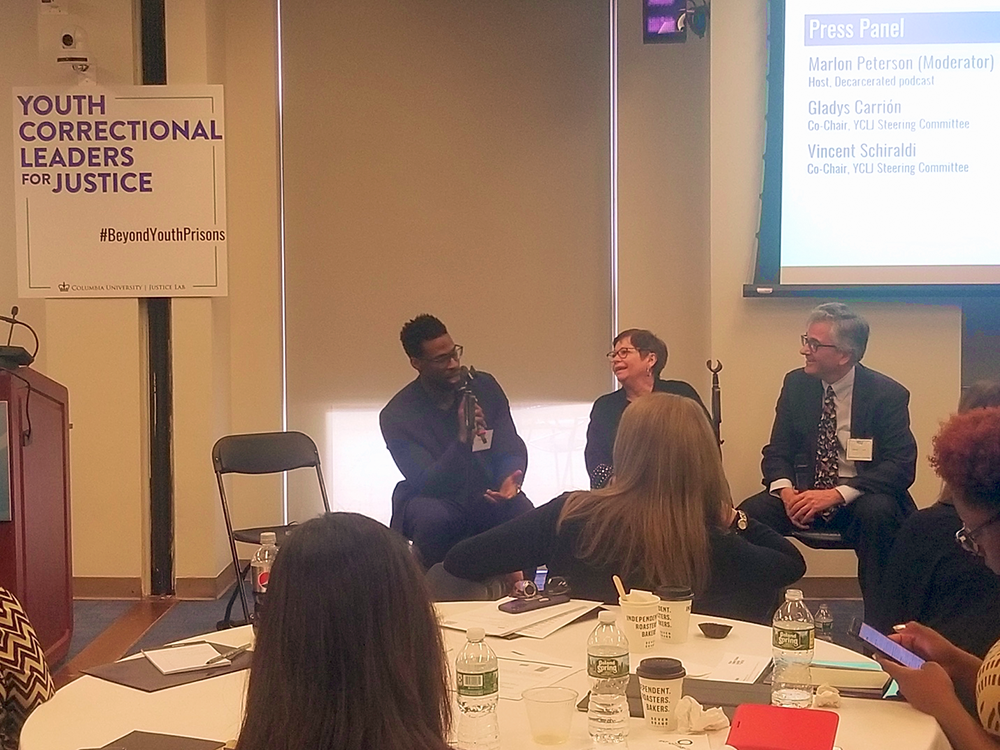NEW YORK — A group of current and former corrections officials announced a campaign Wednesday to close the country’s remaining youth prisons and to further transform the punishment-focused juvenile justice system to a community-based approach.
“The default should not be prison; the default should be community,” said Gladys Carrión, co-chair of Youth Correctional Leaders for Justice, speaking at the Columbia School of Social Work. “We need to redesign our juvenile justice system so that it would be more equitable, rational and efficient to better address the needs of young people.”
 The organization includes current and former officials from several states and localities, including Harris County, Texas; Los Angeles, and Maine, who are interested in closing the nation’s remaining 80 youth prisons where nearly 46,000 young people are incarcerated.
The organization includes current and former officials from several states and localities, including Harris County, Texas; Los Angeles, and Maine, who are interested in closing the nation’s remaining 80 youth prisons where nearly 46,000 young people are incarcerated.
It is a project of the Justice Lab at Columbia University
In 2010, New York state closed four of its most dangerous youth prisons under a federal consent decree. Carrión subsequently closed 21 juvenile prison facilities in her former role as commissioner of the New York State Office of Children and Family Services. She later served as Mayor Bill de Blasio’s first commissioner at the Administration for Children’s Services. She resigned from ACS in 2016 after the agency’s oversight role in the deaths of several children came under scrutiny.
For more information on Community-Based Alternatives, go to JJIE Resource Hub | Community-Based Alternatives
The co-chair of the youth corrections group, Vincent Schiraldi, a former New York City probation commissioner, said he hopes all juvenile prisons in the nation can be closed in a decade, but he fears that communities in upstate New York, where the state Department of Corrections employs more than 19,000 people, may resist facility closures because of job losses.
High juvenile incarceration rates have devastating effects on communities of color, he said.
“We’re telling these communities that we value their children less than other people’s children, and that is not a message lost in our communities of color,” Schiraldi said. “We’re robbing these young people of opportunities to thrive and to be successful adults.”
Black youth are more than five times as likely to be detained or locked up than white youth. Between 2001 and 2015, juvenile incarceration rates fell by 54 percent, but the overall disparity between the numbers of black and white youth in custody has increased 22 percent since 2001, according to the U.S. Department of Justice.
Even though the youth corrections group advocates for shutting juvenile prisons, they do believe that youth should be placed in out-of-home care when cases of public safety absolutely require it, but only for the minimum time necessary to address the risk.
Asked what a world without prisons would look like, Carrión imagines a system where resources and money are reinvested in communities, infrastructure serves young people and reentry and family visitation are made easier.
“How do we move other systems and help other systems move in a direction where you no longer rely on prisons as the default for young people when they commit an offense?” she asked.

If a deficit of support systems in the community contributed to the delinquency of in the first place, why wait until delinquency occurs and placement is made before you put money into building up the community so the child can be released. How about a campaign that really results in community health and wellness as a preventative measure instead of an incarceration alternative. That might be a fix rather than a “band-aid”.
What an interesting idea! To operationalize this change, it will be important to consider all the circumstances that lead to youth incarceration, and how the needs of these youth can be met especially when “home” may be the place that led them to incarceration. Some incarcerated youth I’ve worked with were inducted into a criminal / gang / drug / violent lifestyle by their parents; and some wanted to remain incarcerated because it was safer than their home. How do we rehabilitate the child without first rehabilitating the parents?
What does one do in transfer cases, where juvenile institutions may be the ONLY viable alternative to adult prisons??
Included in this should be the closure of youth “ranches” where youth are imprisoned without charge or conviction!!!